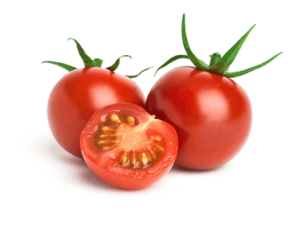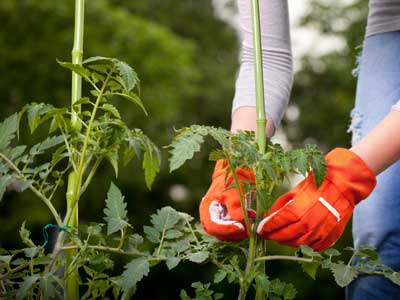Whether you are a novice home gardener or a confident grower, this ‘How to Grow’ guide features everything you need to know about sowing, growing, and caring for tomatoes (Botanical name: Solanum lycopersicum).
Determinate vs. Indeterminate
The difference between tomato types is their growth habit or the shape of their fruit. In this article, we will classify tomatoes based on their growth habit – indeterminate (climbing) and determinate (non-climbing).
Indeterminate Tomatoes
Indeterminate plants grow as vines and require pruning and staking to control their growth. These tomato plants are prolific in terms of height and yield. In theory, they can keep growing as they don’t have a determined size.
Popular heirloom varieties include:
- Amish Paste.
- Beefsteak.
- San Marzano
- Cherry Camp Joy
- Grosse Lisse
- Tigerella
- Oxheart
- Napoli Paste
Determinate Tomatoes
Determinate tomato plants form into a small bush and often don’t require staking due to their small size and growth habit. Once the plant has reached the determined size, the fruit will ripen at once, and the plant will finish its life span.
These varieties are best suited to small gardens, containers and pots.
Popular heirloom varieties include:
- Roma
- Arcadia
- Burnley Gem
Preparation
Sowing Seeds
Grow tomatoes in full sun in a location that receives at least 6 hours of sunlight daily. Tomato plants must be planted in soil with good drainage, whether in containers or garden beds. When grown in garden beds, you’ll need to add organic matter such as compost or aged animal manure. Remove weeds. When growing tomatoes in containers, select a variety best suited to your conditions, use a premium-grade tomato or vegetable potting mix, and ensure plenty of drainage holes in the container for water to escape. Tomato plants don’t like wet feet, and this can result in diseases that adversely affect the fruit. Choose a container with a depth of at least 45cm and a minimum of 40 litres of soil. Be prepared to add liquid fertiliser every couple of weeks to maintain healthy productive plants.
When to Sow
Sow Direct
- Sow seeds directly into the garden 5mm deep and 50cm apart, rows 70 cm apart.
- Ensure the soil is moist (not too wet or too dry).
- Seeds germinate in 5-10 days when the soil is between 21 – 27°C.
- Protect seedlings from pests, animals, and rainy weather until established.
Raise Seedlings
- Fill trays with good quality seed-raising mix.
- Sow to a depth of 5mm.
- Ensure the soil is moist (not too wet or too dry).
- Seeds germinate in 5-10 days when the soil is between 21-27°C.
- Transplant seeds to the garden when they reach 5-10cm tall.
- Plant 50cm apart, rows 70cm apart.
How to Sow
Tomato seeds don’t need soaking or stratification before sowing. You can sow seeds directly into garden beds, trays, or containers, transplanting them into the garden once established. Seeds need warm soil (18-28°C) for germination.
How to Grow
 Tomatoes need consistent amounts of water to develop and sustain the fruit. Too much or too little water is problematic. When the soil is dry below the surface by about 5cm, it’s time to water. Water the bottom of the plant, avoiding the leaves where fungal diseases may develop.
Tomatoes need consistent amounts of water to develop and sustain the fruit. Too much or too little water is problematic. When the soil is dry below the surface by about 5cm, it’s time to water. Water the bottom of the plant, avoiding the leaves where fungal diseases may develop.
Fertilising
If growing in containers, tomato plants need liquid fertiliser every two weeks. For tomato plants grown in garden beds, with soil that was well prepared with aged animal manure or organic compost, the plants may not require fertilising. For poor soil, add slow-release fertiliser when transplanting seedlings and apply liquid fertiliser per the instructions.
Seaweed Fertiliser
Use seaweed fertiliser every two weeks to keep plants healthy and prevent diseases.
Protection from Fruit Fly
Use net bags to cover fruits or create a fruitfly-free zone with a net-covered frame.
Mulching
Mulch well to retain moisture and suppress weeds. Mulching also helps to prevent soil-based diseases from affecting the fruit. Sugar cane mulch is a popular choice.
Transplanting Seedlings
Plant seedlings deeply, remove seed leaves, and plant up to the first set of true leaves to improve root development.
Spacing
Plant in rows 90 cm apart with 45-60 cm between plants. If growing in containers, ensure the roots have at least 45cm depth to spread out and plenty of drainage.
Staking
 Indeterminate tomato plants require staking as they can grow up to 1.8m. Many staking options are available at garden centres, including trellis or tripods. You can make a trellis with anything sturdy enough to support the plant as it grows. You will also need twine to tie the plant to the trellis as it grows. Determinate tomatoes theoretically don’t need staking because they develop into more of a bush-like shape, depending on the variety. As the plant grows, watch its habit and add support if needed.
Indeterminate tomato plants require staking as they can grow up to 1.8m. Many staking options are available at garden centres, including trellis or tripods. You can make a trellis with anything sturdy enough to support the plant as it grows. You will also need twine to tie the plant to the trellis as it grows. Determinate tomatoes theoretically don’t need staking because they develop into more of a bush-like shape, depending on the variety. As the plant grows, watch its habit and add support if needed.
Pruning
Determinate (bush) shaped tomato plants will grow to a specific size with branches of tomatoes. There is no need to prune them. If you see any leaves turning yellow or laying too close to the soil, you can remove them so that soil-borne diseases don’t reach the fruit. Indeterminate (climbing) tomatoes will continue to grow during their life cycle. Remove the side stems (suckers) from between the main stem and fruiting branches, as this will help redirect the natural growth hormones within the plant to the fruit. It also stops awkward branches from forming, which can make the plant become too heavy. Tomatoes enjoy having airflow between their stems and branches as this gives the fruit a chance to receive sunlight while growing.
Harvesting and Preserving
Tomatoes take about 85-100 days to be ready for harvest. When the fruit changes colour it can be cut from the vine using snips/secateurs. You can even twist them from the vine, as long as you are careful not to damage the plant. If you harvest the fruit regularly, the plant will put energy into ripening the remaining fruit. Store the partially ripened tomatoes at room temperature, where they will continue to ripen after harvesting. Preserve the harvest as chutney, sauce, or semi-dried for long-term enjoyment.
Additional Tips
- Avoid replanting in recent tomato beds.
- Avoid planting in soil that recently grew tomatoes, potatoes, capsicums, or eggplants.

